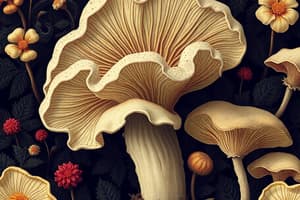Podcast
Questions and Answers
Which statement accurately describes the method of reproduction in fungi?
Which statement accurately describes the method of reproduction in fungi?
- Asexual reproduction is the dominant method for most fungi. (correct)
- Sexual reproduction occurs only between genetically identical fungi.
- All fungi reproduce primarily through sexual reproduction.
- Fungal spores are primarily produced through vegetative reproduction.
What component makes up the cell wall of fungi?
What component makes up the cell wall of fungi?
- Silica
- Cellulose
- Chitin and glucan (correct)
- Peptidoglycan
Which type of hyphae contains cross walls?
Which type of hyphae contains cross walls?
- Thallus hyphae
- Coenocytic hyphae
- Unicellular hyphae
- Septate hyphae (correct)
What is the primary purpose of the fruiting bodies of mushrooms?
What is the primary purpose of the fruiting bodies of mushrooms?
What characteristic is true about yeast colonies when grown on solid media?
What characteristic is true about yeast colonies when grown on solid media?
What is the dominant method of reproduction in fungi?
What is the dominant method of reproduction in fungi?
Which of the following statements is true about yeast reproduction?
Which of the following statements is true about yeast reproduction?
What defines the total mass of hyphae in a fungal structure?
What defines the total mass of hyphae in a fungal structure?
Which condition is necessary for growing Saccharomyces yeasts on Suborand Dextrose agar?
Which condition is necessary for growing Saccharomyces yeasts on Suborand Dextrose agar?
Which statement accurately describes coenocytic hyphae?
Which statement accurately describes coenocytic hyphae?
Flashcards
What are fungal spores?
What are fungal spores?
A specialized structure in fungi that aids in reproduction. Spores are dispersed to new environments where they can germinate and form new fungi.
What are hyphae?
What are hyphae?
A thread-like structure that makes up the body of a filamentous fungi. Hyphae are responsible for absorbing nutrients and spreading the fungus.
What are yeast?
What are yeast?
Unicellular fungi that reproduce asexually by budding. Yeasts are important in brewing, baking, and other industries.
What are mushrooms?
What are mushrooms?
Signup and view all the flashcards
What are saprophytic fungi?
What are saprophytic fungi?
Signup and view all the flashcards
Mycelium
Mycelium
Signup and view all the flashcards
Coenocytic Hyphae
Coenocytic Hyphae
Signup and view all the flashcards
Yeast Budding
Yeast Budding
Signup and view all the flashcards
Fruiting Body
Fruiting Body
Signup and view all the flashcards
Fungal Spores
Fungal Spores
Signup and view all the flashcards
Study Notes
Fungal Characteristics
- Fungi cell walls are composed of chitin and glucan.
- Fungi cannot perform photosynthesis.
- Fungi reproduce using fungal spores; sexual reproduction, while possible, is less common than asexual reproduction.
- Asexual reproduction involves one fungus dividing, resulting in genetically identical offspring.
- Sexual reproduction typically involves two genetically different fungi.
- Fungi are chemoheterotrophs, meaning they obtain energy and carbon from other organisms. Some fungi are saprophytes (decomposers), and some are parasitic.
Fungal Structure
- Filamentous fungi: Composed of hyphae.
- Mycelium: The total mass of hyphae.
- Thallus: The interwoven mass of mycelia.
- Hyphae Types:
- Septate hyphae: Contain cross-walls (septa).
- Coenocytic hyphae: Lack cross-walls.
- Unicellular fungi (yeasts): Reproduce asexually by budding.
- A bud forms on the outer surface of the parent cell.
- Cell wall material is deposited between the bud and the parent cell, eventually leading to separation.
- Yeast colonies resemble bacterial colonies on solid media.
- Examples include Saccharomyces and Candida.
Yeast Growth Conditions
- Media: Typically grown on Sabouraud Dextrose agar (SDA).
- Colony Characteristics:
- Shape: Circular, smooth.
- Elevation: Convex.
- Margin: Entire.
- Pigment: Creamy.
- Growth Conditions: Incubated at 37°C. High sugar concentration and acidic pH in SDA promote yeast growth. Growth can be propagated by 4 way streaking.
Fungal Observation Techniques
- Rhizopus: Wet mount using a needle, lactophenol blue, or cotton blue stain for viewing.
- Aspergillus: Fresh cultures are white; older cultures are black.
- Mushrooms: Visible portions are fruiting bodies, carrying spores. Spores form on gills underneath the cap.
Studying That Suits You
Use AI to generate personalized quizzes and flashcards to suit your learning preferences.




